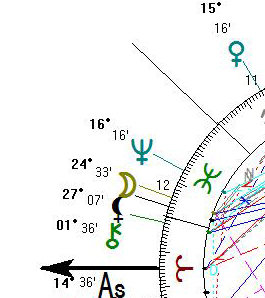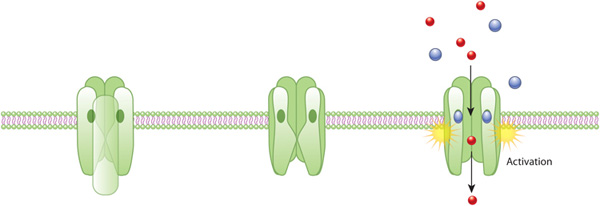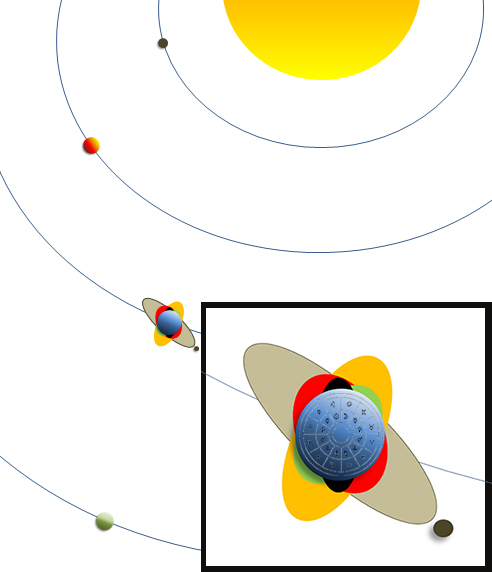|
C.T.Definitions |
The Gravity Code |
|

The Gravity Code This is a reduced preview of one chapter on my book about how Astrology ties
to the core mechanism of life.
Cell communication and gravity Gravity is one force whose effects is so deeply entrenched
in our everyday lives that we probably don't think much about it at all. Gravity
is the force that causes attraction between masses. It's why when you drop an
apple, it falls to the ground. But because gravitational force is proportional
to the mass of the object, only large objects like planets create tangible
attractions. This is why the study of gravity traditionally focused on massive
objects like planets. The gravitational force of earth we experience every day
keeps us on the ground while gravitational forces from other objects (Planets,
Suns, Moon’s) create an up drift in constant changing patterns. This mix of forces shows at peak through tides caused
mainly by Moon and Sun showing the strong effect gravity has on our daily
life’s. Other objects with significant smaller gravitational
effects have been ignored lacking of visible effects but show significance on microbiological level. Our first manned space missions, however, completely
changed how we thought about gravity's effects on biological systems. The force
of gravity doesn't just keep us anchored to the ground; it influences how our
bodies work on the smallest of scales. With the prospect of longer space
missions, researchers working to figure out what a lack of gravity means for our
physiology. Astronauts' bodies have to deal with a gravity-free
environment in space, very different to what they're used to on Earth.
Neutral moment of Micro Gravity It wasn't until explorers traveled to space that any
earthly creature had spent time in a microgravity environment. Scientists observed that returning astronauts had grown
taller and had substantially reduced bone and muscle mass. Intrigued,
researchers started comparing blood and tissue samples from animals and
astronauts before and after space travel to assess the impact of gravity on
physiology. Astronaut-scientists in the largely gravity-free environment of the
International Space Station began to investigate how cells grow while in space. Experiments conducted on Earth, using simulated
microgravity by spinning objects – such as cells – in a centrifuge at fast
speeds, create the same reduced gravity conditions you would experience in
space. All tests found that our cells have evolved to deal with
forces in a world characterized by gravity; if they're suddenly liberated from
gravity's effects, cell communication undergoes extreme changes.
Detecting forces at a cellular level Along with the force of gravity, our cells are also
subjected to additional forces, including tension and shear stresses, as
conditions change within our bodies. Our cells need ways to sense these forces. One of the
widely accepted mechanisms is through what are called mechanism-sensitive ion
channels. These channels are pores on the cell membrane that let particular
charged molecules pass in or out of the cell depending on the forces they detect
(see Tides of the cell). Channels in a cell's membrane act as gatekeepers, opening
or closing to let molecules in or out in response to a particular stimulus. An example of this kind of mechanism-receptor is the PIEZO
ion channel, found in almost all cells. They coordinate touch and pain
sensation, depending on their locations in the body. For instance, a pinch on
the arm would activate a PIEZO ion channel in a sensory neuron, telling it to
open the gates. In microseconds, ions such as calcium would enter the cell,
passing on the information that the arm got pinched. The series of events
culminates in withdrawal of the arm. This kind of force-sensing can be crucial,
so cells can quickly react to environmental conditions. Without gravity, the forces acting on mechanism-sensitive ion
channels are imbalanced, causing abnormal movements of ions. Ions regulate many
cellular activities; if they're not going where they should when they should,
the work of the cells goes haywire. Protein synthesis and cellular metabolism
are disrupted.
Physiology without gravity Over the past three decades, researchers have carefully
teased out how particular kinds of cells and body systems are affected by
microgravity. Since the 1980s, scientists have observed that the absence
of gravity leads to enhanced blood retention in the upper body, and so increased
pressure in the brain. Recent research suggests this heightened pressure reduces
the release of neurotransmitters, key molecules that brain cells use to
communicate. This finding has motivated studies into common cognitive problems,
such as learning difficulties, in returning astronauts.
Cell communication and Gravity There is a clear connection between balance of Gravity and
neurotransmitters creating a focal balance on which imbalance is detected within
the chemical structure of each cell. This focal balance (established at birth of the life form)
is determining imbalance creating the flow of information between cells. With
changing constellation of the basic gravity condition a reaction occurs in order
to regain the focal balance within the whole concept. The all over concept of gravitational balance not only
determines the condition of cell communication it also determines its condition
and growth, shape and vitality. As a result of the collective an individual life
form is established based on these conditions. As soon we neutralize the gravitational condition the life
form adapts to the new environment and changes its conditions creating a strong
imbalance which can lead to complete decline of this life form pending on its
vital stage. A good example is the difference between Sea- and Land
mammals. Gravity effects are the same in any place on earth within the flow of
time. In the mountains just as in the seas the gravitational forces based on
local condition are the same but in the ocean; up drift creates the need for
streamline and float oriented life form and on land a sturdy concept that is
oriented against earth’s gravitational pull. The design of the body in these two
environments is a match to the environmental conditions but the gravitational
force within the cell of both life forms are the same no matter where the life
form develops. It usually takes a few million years until the transformation
develops and is never certain to be abolished or interrupted. The gravitational
effects however remain at all times creating a balance of cell development and
cell communication based on a focal balance at birth time allowing to develop
different designs of life forms according to the conditions of the environment. The conditions in space would produce the same evolutional
effect as if a land mammal adapts to sea life. But here the process will not
work since the gravitational condition interrupts the communication between the
cells of the individual. So the effect of gravitational condition on earth rules
any form of life and development within in its core on a very basic level.
So what is Cell communication actually doing? The study of cell communication focuses on how a cell gives
and receives messages with its environment and with itself. Indeed, cells do not
live in isolation. Their survival depends on receiving and processing
information from the outside environment, whether that information pertains to
the availability of nutrients, changes in temperature, or variations in light
levels. Cells can also communicate directly with one another — and change their
own internal workings in response — by way of a variety of chemical and
mechanical signals. In multi-cellular organisms, cell signaling allows for
specialization of groups of cells. Multiple cell types can then join together to
form tissues such as muscle, blood, and brain tissue. In single-celled
organisms, signaling allows populations of cells to coordinate with one another
and work like a team to accomplish tasks no single cell could carry out on its
own. The study of cell signaling touches multiple biological
disciplines, such as developmental biology, neurobiology, and endocrinology.
Consequently, the relevance of cell communication is quite vast, but major areas
of fundamental research are often divided between the study of signals at the
cell membrane and the study of signals within and between intracellular
compartments. Membrane signaling involves proteins shaped into receptors
embedded in the cell's membrane that biophysically connect the triggers in the
external environment to the ongoing dynamic chemistry inside a cell. Signaling
at the membrane also involves ion channels, which allow the direct passage of
molecules between external and internal compartments of the cell. Scientists
ask: What is the receptor structure that enables it to react to an external
signal (such as a legend or even a mechanical force)? Others ask: Once
triggered, how is the signal processed inside the cell? Cells have evolved a variety of signaling mechanisms to accomplish the transmission of important biological information. Some examples of this variety are receptors that allow ion currents to flow in response to photons, which effectively translates light into chemical messengers inside the cone and rod cells of the retina; growth factors that interact with the cell membrane and can trigger receptors that powerfully affect chromatin structure and the modulation of gene expression; metabolites in the blood that can trigger a cell's receptors to cause the release of a hormone needed for glucose regulation; adhesion receptors that can convey tension-generated forces that direct a cell to stay put or change direction of movement; and developmentally regulated receptors that can strictly guide the path of a migrating cell, ultimately controlling how an entire organism is wired together.
How Astrology connects to all of this Astrology based on the constellation of Planets Sun and Moon in correspondence to our daily life’s and life itself as well as periods of natural occurrence among. It’s the idea of universal clockwork ruling the go of time for anything within eternity, creating basic patterns of encouraging or compromising nature based on the gravitational effects of objects within our solar system. The concept of balance is given at the time of birth. After that moment the shift of gravitational constellation creates adaption and growth as well as imbalance in context to the focal balance at birth time. The effects are based on mass, distance and angle these objects
have to the location setting a distinctive level of gravity pattern ruling the
scenery of gravitational condition and therefore the condition of cell
communication. This assumes the entire spectrum of respond to environmental conditions and growth within.
~Christian Hoffmann 3/2019 |
| Contact | ||||
|
C.T.Definiotions +1-704-905-8459 c.t.definitions@gmail.com |
 |
|||
|
|
|
|||
| @C.T.Definitions 2019 | ||||

